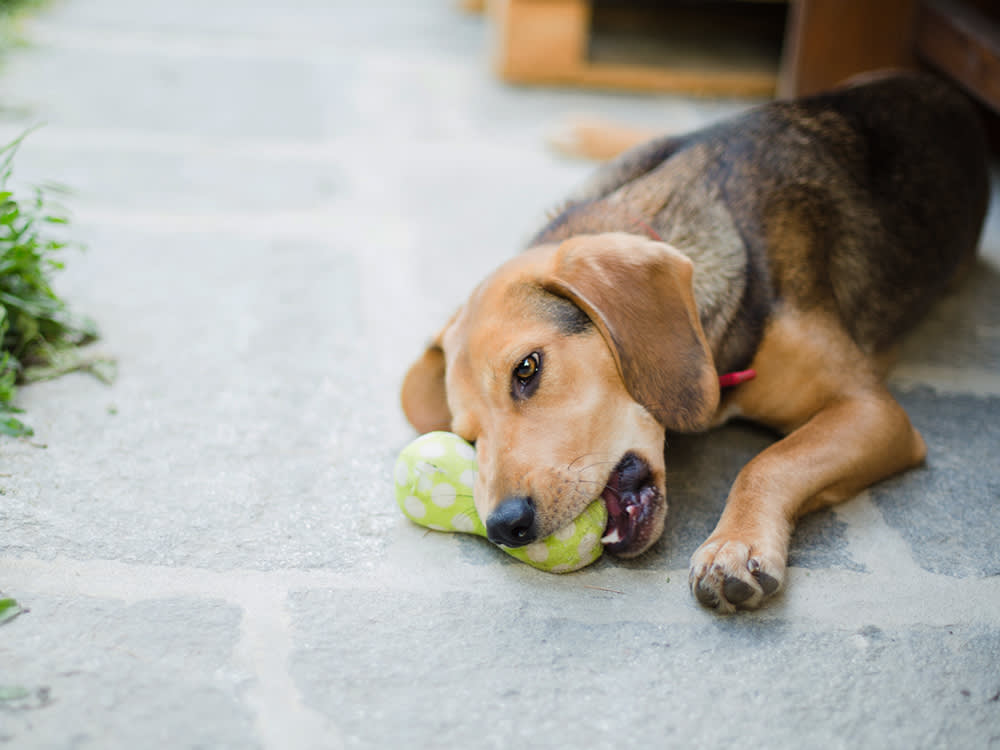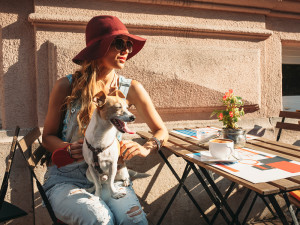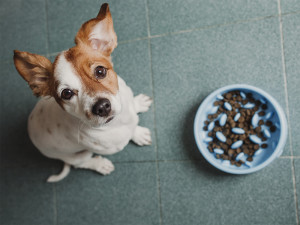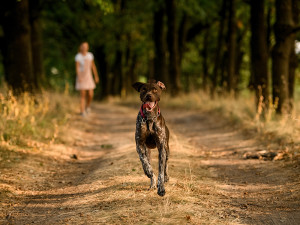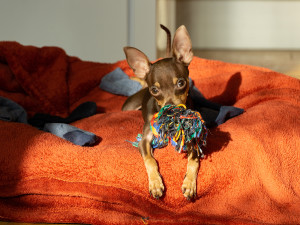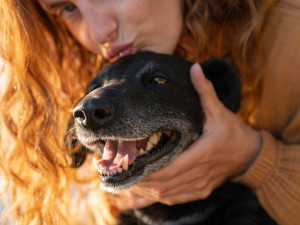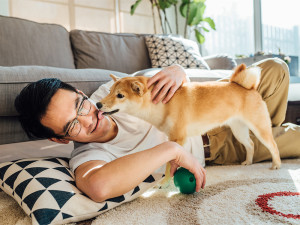How to Get Your Dog to Stop Resource Guarding Their Stuff
If your dog growls when you get near their food or toys, read this right now
Does your dog growl and show their teeth if you come near them while they’re chewing on a bone? Do they stiffen if you try to take a toy from them? If you walk near them while they’re eating, do they eat faster?
If you answered ‘yes’ to any of these questions, your dog is exhibiting behaviour known as ‘resource guarding’, which is any behaviour that a dog displays to convince others to stay away from something they consider valuable. This survival instinct might be useful for dogs in the wild, but it’s not ideal for a member of your family. Keep reading to learn more about resource guarding in dogs – including how to get them to stop.
What is resource guarding in dogs?
Resource guarding is a common – and fixable – piece of normal dog behaviour. Signs of resource guarding in dogs include growling, tooth displaying, stiffening, frantic eating, glaring, snapping, barking, leaning over the resource to shield it and biting. Dogs commonly guard food, toys, treats, bones, rawhide, beds and even another dog or a person.
In most cases, resource guarding is subtle. A dog with a pig’s ear, for example, may turn their body to shield their precious treasure from anyone approaching, or they may pick it up and carry it to another room. They might put their paw on it or even give you a look that means something along the lines of ‘don’t even think about’ or ‘please don’t take it away’. Few people are troubled by such mild forms of resource guarding.
Even though resource guarding can become far more serious, there’s some good news. One, there are ways to prevent it in most dogs. Two, behaviour modification plans are easy to implement and effective at improving the dog’s behaviour. Three, many people choose to simply live with it, managing it as best they can. That may not sound very inspiring, but I consider any solution that keeps a dog at home and people safe while allowing a loving relationship between the two to flourish and grow to be a success.
How to prevent resource guarding
Dogs are often nervous about losing what they value. With that in mind, a key aspect of preventing resource guarding, including its most common form – food bowl aggression – is to teach dogs to be happy when someone approaches or reaches for their treasure. Dogs who are happy in a particular context are a whole lot less likely to act aggressively.
Creating this positive emotional reaction is simple: teach your dog to associate the approach of a person with treats. I advise people to walk towards their dog and toss a really good treat into the bowl or near their treasure. Once the dog is used to this, the next step is to walk over, pick up the bowl or the treasure, deliver a treat (in the bowl is fine) and then return the bowl or the treasure. It’s important to do this quickly – within a few seconds at most – so your dog doesn’t feel like they’re being teased.
I suggest doing this only once or twice per session; even though your dog gets a treat, the interruption can still be irritating. I imagine dogs in that situation feel like I do when a restaurant waiter refills my water glass every time I take a sip: mildly harassed.
Avoid bad strategies
You may have been advised to put your hand in your dog’s food bowl, or pick up the bowl and hold it. Unfortunately, this strategy is far more likely to lead to food bowl aggression than to prevent it. Such actions are irksome, so it’s no surprise that many dogs will lose their temper eventually. While some dogs will never become resource guarders, even when provoked, others can be taught to be aggressive around their food. Some of the worst resource guarders I’ve ever seen were taught to be that way by their well-intentioned humans.
People accidentally teach dogs to guard their resources in other ways, as well. If your dog has a bone (or food or a shoe or the remote control) and you take it from them, they learn that they lose treasures unless they take action. To avoid that, instead of taking something from your dog, trade them for it. Hold a treat or other desirable object right by their nose, and if they drop the contraband, give them the offered item. This teaches them that they get paid for letting go of things (instead of getting mugged whenever they have something valuable).
It’s very important to help your dog feel happy about releasing items and to actively avoid making it a negative experience. Trading is far better than a battle, and it’s very effective, especially if they’re ‘trading up’ – getting something better than what they surrendered.
Another strategy is to have your dog drop the object, give them a treat and then give them back the item. This helps them learn that it’s worthwhile to release things. I like to teach the cue ‘drop it’ so that if a dog gets something they shouldn’t have, I can ask them to release it before they damage it – or themselves.
How to stop resource-guarding behaviour
Giving extra treats when your dog has something of value is a useful technique to prevent resource guarding, but it can also be used to stop an existing behaviour. (If your dog has previously bitten or threatened anyone, I advise having a behaviourist supervise this interaction.)
Start by standing outside the dog’s reaction zone and tossing high-quality treats to them. The goal is to make them happy that a person is present when they have a treasure. This change in their emotional response is what will lead to a change in their behaviour. The closer you get, the more intense the situation will become. The intensity will also increase if the dog has a more highly valued item, or if you approach, reach for or pick up the resource.
Work at each level of intensity until your dog is comfortable, and only then progress to something harder. The highest-intensity context is to approach your dog and take something that they value highly. Success can only be achieved by gradually working towards that goal and requires many steps and many repetitions over a period of weeks and months.
Living with resource guarding
Despite the challenges of sharing a home with a dog who guards resources, it’s common for people to choose to live with it. People who have a dog with this predilection know when to expect the behaviour, and they simply avoid going near their dog when they have a valued item. This predictability may account for the lack of concern many have about resource guarding. Of course, predictability varies depending on the household. A single person who rarely entertains is in a very different situation than a family with five small kids who have additional children over to play nearly every day.
Years ago, the standard view was that a dog shouldn’t be approached at mealtimes or when they are chewing a bone or playing with a favourite toy, and there’s a lot of good sense in that. If you don’t bother your dog while they’re eating, and you purposely avoid going near them when they have a bone or other treasure, trouble can be averted.
Life with a dog who allows anyone to take anything away from them is pretty easy, but that’s really a lot to ask of even the dearest, sweetest dog on the planet. There are, of course, dogs who are as unlikely to guard resources as they are to calculate Schrödinger’s wave equation. But we shouldn’t assume that dogs who are lovely – but perhaps not so nonchalant about being mugged – are bad.
With dogs who are at risk of causing injury, it’s obviously critical to have some way to keep everyone is safe. You can deal with this problem by preventing situations that trigger problem behaviour (particularly aggression) and with behaviour modification that alters how your dog behaves when they have something of value. How important it is to train your dogs not to resource guard is an individual decision – you might be highly committed or willing to simply live with it.
The bottom line: resource guarding is common though less than desirable dog behaviour. I’m not excusing it or saying that it’s not a problem, but like barking and chewing, it is accepted by many people as part of living with a dog – although clearly, it’s nobody’s favourite part. Though it can be changed and improved with behaviour modification, plenty of people choose to accept it, figuring that life is too short to demand perfection of their best friend.
